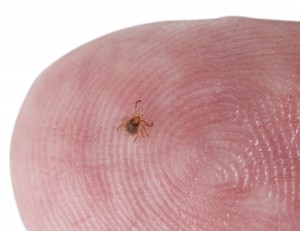Ontarians are reminded to protect themselves from tick bites while enjoying or working outdoors this summer.
Lyme disease can be serious. If not identified early, infection can lead to recurring arthritis, neurological problems, numbness, and paralysis. Lyme disease is spread to humans through the bite of an infected blacklegged tick.
The most common Lyme disease telltale sign is a rash. This easily identifiable rash begins to form a “bull’s eye shape”, or look like a target.It can begin to form anywhere from 3-30 days after the initial tick bite. Most patients report their rashes showing up after one week of noticing the insect bite.
Tick populations are established in known risk areas throughout the province. In addition, multiple factors are allowing ticks to potentially establish populations in new areas throughout the province. These factors include climate change, warmer winter temperatures and ticks’ ability to “hitch-hike” on suitable hosts, like birds or deer. Ticks live near the ground in woodlands, tall grasses and bushes, and thrive in moist environments, like those found underneath old leaves on the forest floor. The best way to prevent tick bites include:
- Wearing closed-toe shoes, long-sleeved shirts and pants
- Pulling your socks over your pant legs to prevent ticks from crawling up your legs
- Wearing light-coloured clothing to spot ticks more easily
- Using insect repellent containing DEET or Icaridin on clothing as well as on exposed skin, following the product instructions carefully
- Showering or bathing within two hours of being outdoors to remove ticks that can be on your skin but not yet attached
- Doing a daily full body check for ticks. Young blacklegged ticks can be as small as a poppy seed, so look carefully. Check children and pets for ticks as well.
- Placing outdoor clothing through the dryer cycle for 60 minutes on high heat before washing to kill any ticks that may be hard to see.
If you or a family member are experiencing serious symptoms and health effects, or have concerns about any symptoms, please contact your health care provider.
QUICK FACTS
- Dogs and cats can carry the ticks into your home and place families at risk of being bitten. Check your pets for ticks daily and talk with your vet about keeping your pet protected from ticks.
- The most commonly known symptom of Lyme disease is an expanding, non-itchy to mildly-itchy skin rash. The rash can begin at the site of the tick bite between three and 30 days after exposure and usually grows in size for several days. Although many people never get or see a rash.
- When doing a full body check for ticks, pay close attention to areas such as your scalp, ankles, armpits, groin, naval and behind your ears and knees. Use a mirror to check the back of your body or having someone else check for you.
- Most cases of Lyme disease can be treated successfully with a few weeks of antibiotics if diagnosed and treated early. The earlier treatment is received the better.
What are the symptoms of Lyme disease?
Symptoms of Lyme disease can be different from person to person. You may not have any symptoms at all, while others may suffer severe symptoms.
Symptoms of Lyme disease can include any of the following:
- skin rash
- headache
- fever or chills
- fatigue (tiredness)
- spasms or weakness
- numbness or tingling
- swollen lymph nodes
o oval-shaped organ found in the body, such as the armpit or stomach
Additional symptoms can include:
- dizziness
- abnormal heartbeat
- muscle and joint pain
- paralysis (unable to move parts of your body)
- mental confusion or inability to think clearly (brain fog)
- nervous system disorders (involving the brain, nerves and spinal cord)
Sometimes, you may not experience symptoms for weeks after you are bitten by an infected tick.
If left untreated, Lyme disease symptoms can last from months to years. In rare cases, Lyme disease can lead to death.
Post-treatment symptoms
You may experience symptoms that last months to years after treatment. This is a condition known as post-treatment Lyme disease syndrome (PTLDS).
Symptoms can include:
- sleep disturbance
- fatigue (tiredness)
- muscle and joint pain
- mental confusion or inability to think clearly
What do you do if you become ill?
See your health provider right away if you develop symptoms of Lyme disease in the weeks after a tick bite. Tell them about your symptoms and if you participated in any activities in an at-risk area.
If you saved the tick that bit you, bring it to your medical appointment. Tell them:
- how long the tick was attached to you
- where you were when you were bitten by the tick
The sooner you get treatment, the better your chance of recovery.






I was diagnosed of Lyme disease four years ago. I was so terribly sick. I think my worst complaint was the severe headache. I was taken doxycycline hyclate 100 mg as treatment for Lyme disease, twice a day for 21 days. and didn’t seem to be improving. I did not display a rash or any kind of bull’s eye. Diagnosis was from blood test. We tried every shots available but nothing worked. My Lyme Disease got significantly worse and unbearable because of her cognitive thinking. In 2015, our physician advised we go with natural treatment and was introduced to Organic Herbal Clinic natural organic Lyme Disease Herbal formula, I had a total decline of symptoms with this treatment, the fever, joint pain, weakness, shortness of breath, and anxiety. and others has subsided. Visit Organic Herbal Clinic official website ww w. organicherbalclinic. com